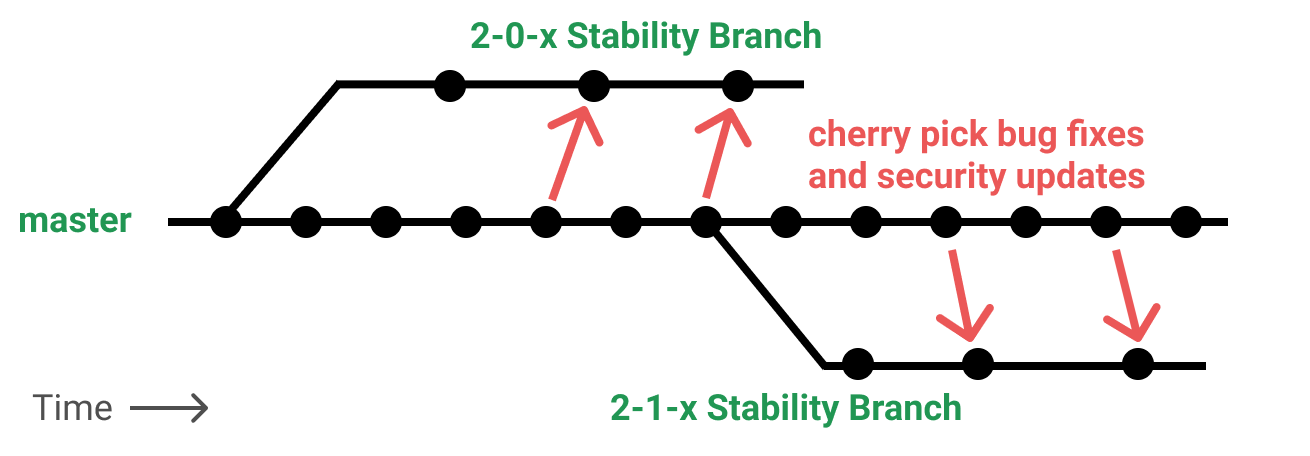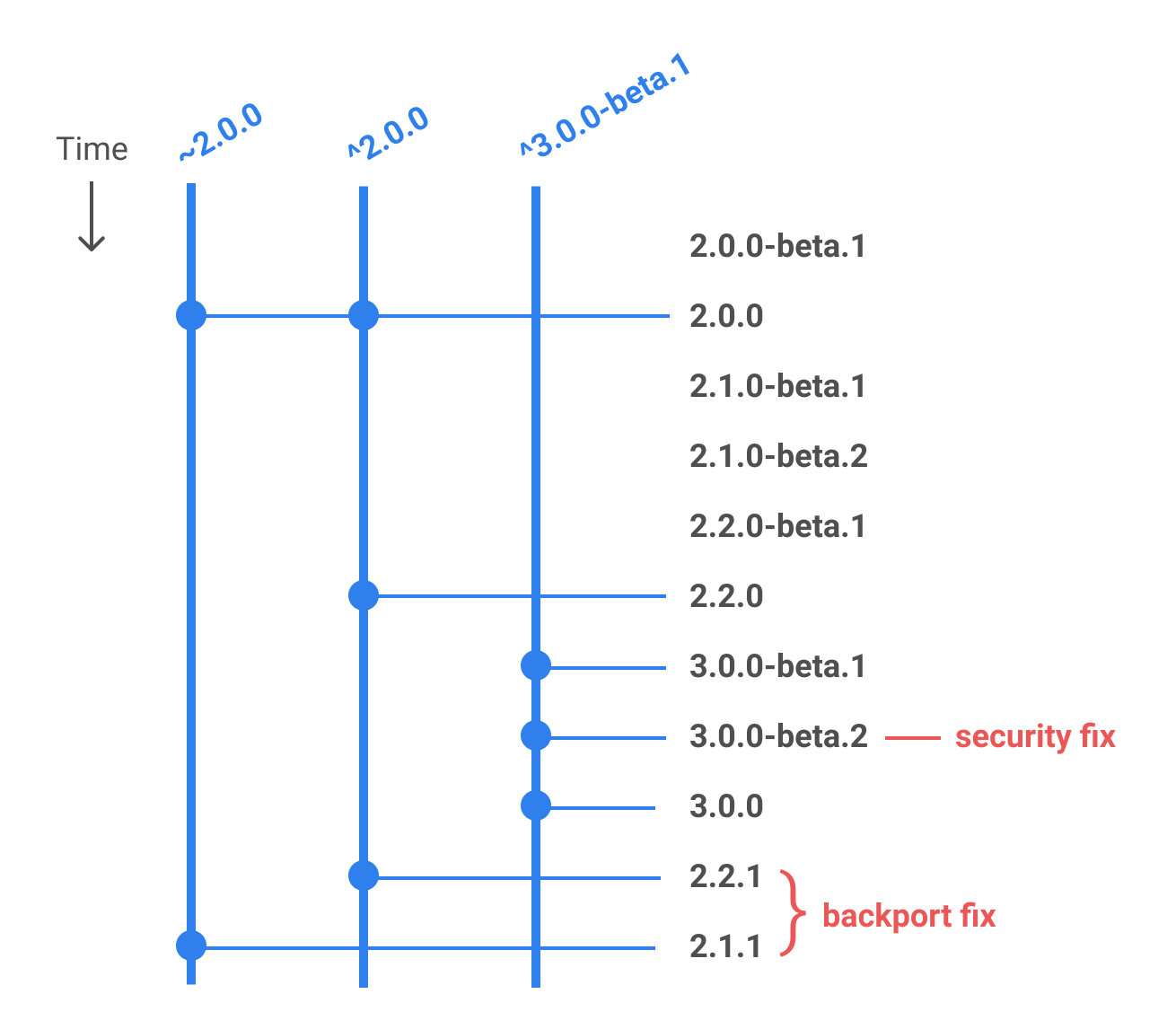7.8 KiB
Electron Versioning
Version 1.x
Electron versions < 2.0 have not conformed to the semver spec. Major versions corresponded to end-user API changes. Minor versions corresponded to Chromium major releases. Patch versions corresponded to new features and bug fixes. While convenient for developers merging features, it creates problems for developers of client-facing applications. The QA testing cycles of major apps like Slack, Stride, Teams, Skype, VS Code, Atom, and Desktop can be lengthy and stability is a highly desired outcome. There is a high risk in adopting new features while trying to absorb bug fixes.
Here is an example of the 1.x strategy:
An app developed with 1.8.1 cannot take the 1.8.3 bug fix without either absorbing the 1.8.2 feature, or by backporting the fix and maintaining a new release line.
Version 2.0 and Beyond
There are several major changes from our 1.x strategy outlined below. Each change is intended to satisfy the needs and priorities of developers/maintainers and app developers.
- Strict use of semver
- Introduction of semver-compliant
-betatags - Introduction of semantic-release style commit messages
- Clearly defined stabilization branches
- Regular release cadence
We will cover in detail how git branching works, how npm tagging works, what developers should expect to see, and how one can backport changes.
semver
From 2.0 onward, Electron will follow semver.
Below is a table explicitly mapping types of changes to their corresponding category of semver (e.g. Major, Minor, Patch).
- Major Version Increments
- Chromium version updates
- node.js major version updates
- Electron breaking API changes
- Minor Version Increments
- node.js minor version updates
- Electron non-breaking API changes
- Patch Version Increments
- node.js patch version updates
- fix-related chromium patches
- electron bug fixes
Note that most chromium updates will be considered breaking. Fixes that can be backported will likely be cherry-picked as patches.
Stabilization Branches
Stabilization branches are branches that run parallel to master, taking in only cherry-picked commits that are related to security or stability. These branches are never merged back to master.
Stabilization branches are always either major or minor version lines, and named against the following template $MAJOR-$MINOR-x e.g. 2-0-x.
We allow for multiple stabilization branches to exist simultaneously, and intend to support at least two in parallel at all times, backporting security fixes as necessary.

Older lines will not be supported by GitHub, but other groups can take ownership and backport stability and security fixes on their own. We discourage this, but recognize that it makes life easier for many app developers.
Beta Releases and Bug Fixes
Developers want to know which releases are safe to use. Even seemingly innocent features can introduce regressions in complex applications. At the same time, locking to a fixed version is dangerous because you’re ignoring security patches and bug fixes that may have come out since your version. Our goal is to allow the following standard semver ranges in package.json :
- Use
~2.0.0to admit only stability or security related fixes to your2.0.0release. - Use
^2.0.0to admit non-breaking reasonably stable feature work as well as security and bug fixes.
What’s important about the second point is that apps using ^ should still be able to expect a reasonable level of stability. To accomplish this, semver allows for a pre-release identifier to indicate a particular version is not yet safe or stable.
Whatever you choose, you will periodically have to bump the version in your package.json as breaking changes are a fact of Chromium life.
The process is as follows:
- All new major and minor releases lines begin with a
-beta.Ntag forN >= 1. At that point, the feature set is locked. That release line admits no further features, and focuses only on security and stability. e.g.2.0.0-beta.1. - Bug fixes, regression fixes, and security patches can be admitted. Upon doing so, a new beta is released incrementing
N. e.g.2.0.0-beta.2 - If a particular beta release is generally regarded as stable, it will be re-released as a stable build, changing only the version information.
e.g.
2.0.0. - If future bug fixes or security patches need to be made once a release is stable, they are applied and the patch version is incremented accordingly
e.g.
2.0.1.
For each major and minor bump, you should expect too see something like the following:
2.0.0-beta.1
2.0.0-beta.2
2.0.0-beta.3
2.0.0
2.0.1
2.0.2
An example lifecycle in pictures:
- A new release branch is created that includes the latest set of features. It is published as
2.0.0-beta.1.
- A bug fix comes into master that can be pack-ported to the release branch. The patch is applied, and a new beta is published as
2.0.0-beta.2.
- The beta is considered generally stable and it is published again as a non-beta under
2.0.0.
- Later, a zero-day exploit is revealed and a fix is applied to master. We pack-port the fix to the
2-0-xline and release2.0.1.
A few examples of how various semver ranges will pick up new releases:
Missing Features: Alphas, and Nightly
Our strategy has a few tradeoffs, which for now we feel are appropriate. Most importantly that new features in master may take a while before reaching a stable release line. If you want to try a new feature immediately, you will have to build Electron yourself.
As a future consideration, we may introduce one or both of the following:
- nightly builds off of master; these would allow folks to test new features quickly and give feedback
- alpha releases that have looser stability constraints to betas; for example it would be allowable to admit new features while a stability channel is in alpha
Feature Flags
Feature flags are a common practice in Chromium, and is well-established in the web-development ecosystem. In the context of Electron, a feature flag or soft-branch must have the following properties:
- is is enabled/disabled either at runtime, or build-time; we do not support the concept of a request-scoped feature-flag
- it completely segments new and old code paths; refactoring old code to support a new feature violates the feature-flag contract
- feature flags are eventually removed after the soft-branch is merged
We reconcile flagged code with our versioning strategy as follows:
- we do not consider iterating on feature-flagged code in a stability branch; even judicious use of feature-flags is not without risk
- you may break API contracts in feature-flagged code without bumping the major version. Flagged code does not adhere to semver
Semantic Commits
We seek to increase clarity at all levels of the update and releases process. Starting with 2.0.0 we will require that all commits adhere to the following commit-message standard before merging to master.
- Commits that would result in a semver major bump must start with
BREAKING CHANGE:. - Commits that would result in a semver minor bump must start with
feat:. - Commits that would result in a semver patch bump must start with
fix:.
All other commit messages will be rejected from merging to master.
- We allow squashing of commits, provided that the squashed message adheres the the above message format.
- A pull-request can contain non-conforming commit messages, however the commits must adhere to the naming standard before a merge can be approved.


